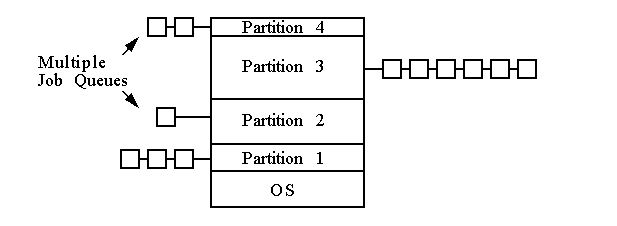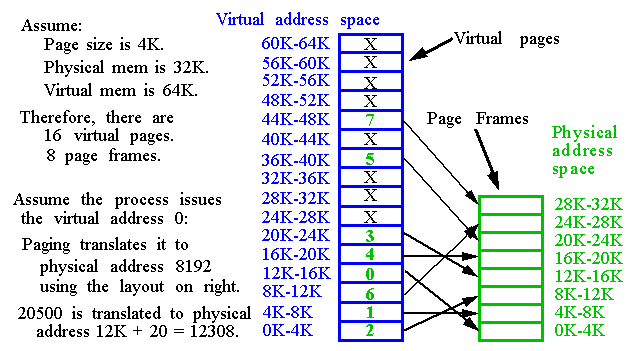-
What comprises the state of a running program (a process or task)?
-
If a second process,
P2
, is to be created and run (not shown), then the state of
P1
must be saved so it can be later resumed with no side-effects.
-
Since only one copy of the registers exist, they must be saved in memory.
-
We'll see there is hardware support for doing this on the Pentium later.
-
For now, let's focus on the organization and management of memory.
-
Ideally, programmers would like a fast, infinitely large nonvolatile memory.
-
In reality, computers have a memory hierarchy:
-
Cache
(SRAMS): Small (KBytes), expensive, volatile and very fast (< 5ns).
-
Main Memory
(DRAM): Larger (MBytes), medium-priced, volatile and medium-speed (<80ns).
-
Disk
: GBytes, low-priced, non-volatile and slow (ms).
-
Therefore, the OS is charged with managing these limited resources and creating the illusion of a fast, infinitely large main memory.
-
The Memory Manager portion of the OS:
-
Tracks memory usage.
-
Allocates/Deallocates memory.
-
Implements virtual memory.
-
In a multiprogramming environment, a simple memory management scheme is to divide up memory into
n
(possibly unequal) fixed-sized partitions.
-
These partitions are defined at system start-up and can be used to store all the segments of the process (e.g.,
code
,
data
and
stack
).
-
Advantage: it's simple to implement.
-
However, it utilizes memory poorly. Also, in time sharing systems, queueing up jobs in this manner leads to unacceptable response time for user processes.
-
In a
variable-sized
partition scheme, the number, location and size of memory partitions vary dynamically:
-
(1) Initially, process
A
is in memory.
-
(2) Then
B
and
C
are created.
-
(3)
A
terminates.
-
(4)
D
is created,
B
terminates.
-
Problem: Dynamic partition size improves memory utilization but complicates allocation and deallocation by creating holes (
external fragmentation
).
-
This may prevent a process from running that could otherwise run if the holes were merged, e.g., combining
X1
and
X2
in previous slide.
-
Memory compaction is a solution but is rarely used because of the CPU time involved.
-
Also, the size of a process's data segments can change dynamically, e.g.
malloc()
.
-
If a process does not have room to grow, it needs to be moved or killed.
-
The hard disk can be used to allow more processes to run than would normally fit in main memory.
-
For example, when a process blocks for I/O (e.g. keyboard input), it can be
swapped
out to disk, allowing other processes to run.
-
The movement of whole processes to and from disk is called
swapping
.
-
The disk can be used to implement a second scheme,
virtual memory
.
-
Virtual memory allows processes to run even when their total size (code, data and stack) exceeds the amount of physical memory (installed DRAM).
-
This is very common, for example, in microprocessors with 32-bit address spaces.
-
If an OS supports
virtual memory
, it allows for the execution of processes that are only
partially
present in main memory.
-
OS keeps the parts of the process that are currently in use in main memory and the rest of the process on disk.
-
When a new portion of the process is needed, the OS swaps out older "
not recently used
" memory to disk.
-
Virtual memory also works in a multiprogrammed system.
-
Main memory stores bits and pieces of many processes.
-
A process blocks whenever it requires a portion of itself that is on disk, much in the same way it blocks to do I/O.
-
The OS schedules another process to run until the referenced portion is fetched from disk.
-
But swapping out portions of memory that vary in size is not efficient.
-
External fragmentation is still a problem (it reduces memory utilization).
-
Two concepts:
-
Segmentation: Allows the OS to "share" code and enforce meaningful constraints on the memory used by a process, e.g. no execution of data.
-
Paging: Allows the OS to efficiently manage physical memory, and makes it easier to implement virtual memory.
-
We will refer to addresses which appear on the address bus of main memory as a
physical addresses
.
-
Processes generate
virtual addresses
, e.g., MOV EAX, [EBX]
-
Note, the value given in [EBX] can reference memory locations that exceed the size of physical memory.
-
(We can also start with
linear addresses
, which are
virtual addresses
translated through the segmentation system, to be discussed).
-
All virtual (or linear) addresses are sent to the
Memory Management Unit
(MMU) for translation to a physical address.
-
The virtual (and physical) address space is divided into
pages
.
-
Page size is architecture dependent but usually range between 512- 64K.
-
Corresponding units in physical memory are called
page frames
.
-
Pages and page frames are usually the same size.
-
Note that 8 virtual pages are not mapped into physical memory (indicated by an
X
on the previous slide).
-
A
present
/
absent
bit in the hardware indicates which virtual pages are mapped into physical RAM and which ones are not (out on disk).
-
What happens when a process issues an address to an unmapped page?
-
MMU notes page is unmapped using present/absent bit.
-
MMU causes CPU to trap to OS - page fault.
-
OS selects a page frame to replace and saves its current contents to disk.
-
OS fetches the page referenced and places it into the freed page frame.
-
OS changes the mem map and restarts the instruction that caused the trap.
-
Paging allows the physical address space of a process to be
noncontiguous
!
-
This solves the
external fragmentation
problem (since any set of pages can be chosen as the address space of the process).
-
However, it generally doesn't allow 100% mem utilization, since the last page of a process may not be entirely used (
internal fragmentation
).
-
Addresses Translation by the MMU
-
Two important issues w.r.t the Page Table:
-
Size
:
-
The Pentium uses 32-bit virtual addresses.
-
With a 4K page size, a 32-bit address space has 2
32
/2
12
= 2
20
or 1,048,576 virtual page numbers !
-
If each page table entry occupies 4 bytes, that's 4MB of memory, just to store the page table.
-
For 64-bit machines, there are 2
52
virtual page numbers !!!
-
Performance
:
-
The mapping from virtual-to-physical addresses must be done for
EVERY
memory reference.
-
Every instruction fetch requires a memory reference.
-
Many instructions have a memory operand.
-
Therefore, the mapping must be extremely fast, a couple nanoseconds, otherwise it becomes the bottleneck.
-
Single page table stored in an array of fast hardware registers.
-
OS loads registers from memory when a process is started.
-
Advantage: No memory references are needed for the page table.
-
Disadvantage: Context switches require the entire page table to be loaded.
-
If it is large, this will be expensive.
-
Page table kept entirely in main memory.
-
Single register points to the start of the page table.
-
Advantage: Context switches only require updating the register pointer.
-
Disadvantage: One or more memory references are needed to read page table entries for each instruction.
-
Modern computers keep "frequently used" page table entries on chip in a cache (similar to first alternative above) and the others in main memory (similar to the second alternative).
-
Instead of using only one level of indirection, use two.
-
This addresses page table size problem since many of the second-level page tables need not be defined (and therefore stored in main memory).
-
Note that two page faults can occur for a single memory reference.
-
If the second-level page table is not in memory, a page fault occurs.
-
If the page that the second-level entry refers to is not in memory, another page fault occurs.
-
In general,
Page Frames
are machine dependent with the following info:
-
Page Frame address
: Most significant bits of physical memory address.
-
Present/Absent bit
: If 1, page is in memory, if 0, it is on disk.
-
Modified bit
: If set, page has been written to, e.g. it is `dirty'.
-
Referenced bit
: Used in the OS page replacement algorithm.
-
Protection bits
: Specifies if data in page can be read/written/executed.
-
With two-level paging, one memory reference could require three memory accesses !
-
In order to reduce the number of times this occurs, a fast lookup table called a
TLB
is added as a hardware cache in the microprocessor.
-
Number of TLB entries varies from 8 to 2048.
-
When a
TLB miss
occurs:
-
A trap occurs and an OS routine handles the fault. The instruction is then restarted.
-
The OS routine copies one (or more) page frame(s) from the page table in memory to one (or more) of the TLB entries.
-
Therefore, if page is referenced again soon, a
TLB hit
occurs eliminating the memory reference for the page frame.







